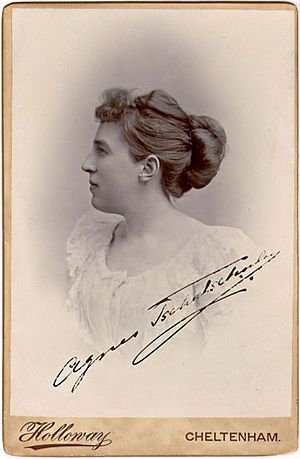Agnes Tschetschulin facts for kids
Agnes Tschetschulin (born February 24, 1859 – died April 23, 1942) was a talented Finnish composer and violinist. She was known for performing her music around the world.
Agnes was born in Helsinki, Finland. Her parents were Feodor and Hilda Eckstein Tschetschulin. She had three sisters: Maria, Melanie, and Eugenie. Her mother, Hilda, often hosted musical gatherings at their home. Her father, Feodor, owned a steamboat company. After her father passed away in 1871, her oldest sister, Maria Tschetschulin, became the first woman to attend the University of Helsinki. Maria hoped to gain skills to help support their family.
Contents
Agnes's Musical Journey
Agnes Tschetschulin started her music studies at the Helsinki Music Institute. This school is known today as the Sibelius Academy. She studied there from 1882 to 1885. Agnes was one of the first four students to graduate from this institute.
Studying in Berlin
After graduating, Agnes received a special grant from the Finnish government. This grant allowed her to travel to Berlin, Germany. There, she studied at the Königliche Hochschule für Musik. Today, this school is called the Berlin University of the Arts. She had many famous teachers, including Woldemar Bargiel and Joseph Joachim.
Touring with a String Quartet
After finishing her studies, Tschetschulin spent several years touring. She was part of an all-female string quartet. A string quartet is a group of four musicians who play string instruments. This group was put together by Marie Soldat. Marie played the first violin. Agnes played the second violin. Gabriele Roy played the viola, and Lucy Campbell played the cello.
Their group was managed by the Herman Wolff Agency. This agency also managed the famous Berlin Philharmonic orchestra. The quartet was promoted as the world's first professional all-female string quartet.
Later Life and Legacy
In 1892, Agnes Tschetschulin began teaching violin. She taught at the Cheltenham Ladies' College in England. In 1904, she became a British citizen. She then moved to London to work as a freelance musician. This meant she worked independently, taking on various musical jobs.
During World War I, she returned to Finland. Later, she moved to Stockholm, Sweden. She lived there until she passed away in 1942. Agnes was buried in Stockholm with her friend, the pianist Tora Hwass (1861–1918).
Agnes's Compositions
Agnes Tschetschulin's music was published by N. Simrock and Skandinavisk Musikforlag. Her compositions include:
Chamber Music
- Alla Zingaresca (for violin and piano)
- Berceuse (for violin and piano)
- Puszta Film
- Romance (for violin and piano)
- Valse gracieuse
Orchestral Music
- Britain's Sons (a march)
- Gavotte (for violin and orchestra or piano)
- March of the Boys of Vöyri
Piano Music
- March for the Finnish Guard on its return from war 1877–78 (also made for wind band)
- Stemmingsbillede (Mood Picture)
- Valse gracieuse
Vocal Music
- At least three lieder (songs)
- Prayer


